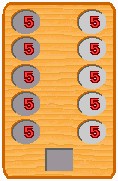Geisterfahrer → German, Portuguese.
| Geisterfahrer |
| Inventor: Ralf Gering, 2004 |
| Variant of: Kalah |
| Ranks: Two |
| Sowing: Multiple laps |
| Region: Germany |
Geisterfahrer was invented on February 18, 2004, by Ralf Gering, Germany. Its name literally means Ghostdrivers and is used in German for persons who drive on the wrong side of a motorway. This bizarre game might fit best for Halloween.
It has in common with Cirk (a mancala game invented by Corné van Moorsel in 1998):
- two kinds of pieces which are owned by the players
- one player is playing clockwise, the other counterclockwise
New features are:
- The players sit side by side at one end of the board.
- Most of the time pieces, which are called cars ("Autos"), are distributed in pairs.
- Another lap is initiated when the last counter is dropped into a non-empty hole in which the opponent then owns only a minority of pieces.
- The first player who cannot play wins. The game would be called in combinatorial game theory a misère variant.
Rules
The board consists of 2x5=10 holes and a big hole at one end called graveyard ("Friedhof"; short for: "Autofriedhof" = car dump). The graveyard is located between the players and the actual playing area.
Initial Position
Each player has 25 cars. One player drives the white ambulances ("Krankenwagen"), his opponent the black hearses ("Leichenwagen"). Black has initially 5 hearses in each hole of the left row, and White, sitting to the right of Black, has at the beginning 5 ambulances in each hole of the right row.
Black moves first. Black distributes the cars clockwise, while White distributes them counterclockwise.
You must start a move from a hole in which at least half of the contents are owned by you. The side of the board does not matter.
You always take all the contents of a hole.
If the emptied hole contained more own cars than cars of the opponent, you drop in the following holes pairs of one own and one opponent's car and eventually the remaining own cars, one by one.
If the emptied hole contained as many own cars as opponent's cars, you drop at first in the following hole an opponent's car (thus making the number of cars remaining in your hand uneven), then pairs of one own and one opponent's car and finally the remaining car of your own color.
The last car dropped is therefore always a single car owned by you.
If you dropped the last car into a hole which then contains at least as many own cars as opponent's cars, you must continue the move by distributing its contents as described.
You can drop only your own cars in the graveyard. If you have to drop in this step an opponent's car or a pair, you must drive round (i.e. omit) the graveyard.
If you drop the last car into the graveyard, you have a bonus move as in Kalah or Sungka, i.e. you move again.
The move ends when the last car is dropped into an empty hole or a hole which despite the last car dropped into it still contains more opponent's cars than your own cars.
The game ends when one player cannot move. This player is declared the winner. A draw is not possible.
The endgame tends to be rather tricky because common sense does not work well.
References
- Gering, R.
- Geisterfahrer (e-mail to Yahoo's Mancala Games mailing list). February 24, 2004.
Copyright
© Wikimanqala.
By: Ralf Gering
Under the CC by-sa 2.5 license.
